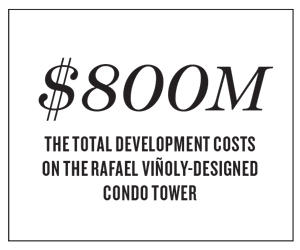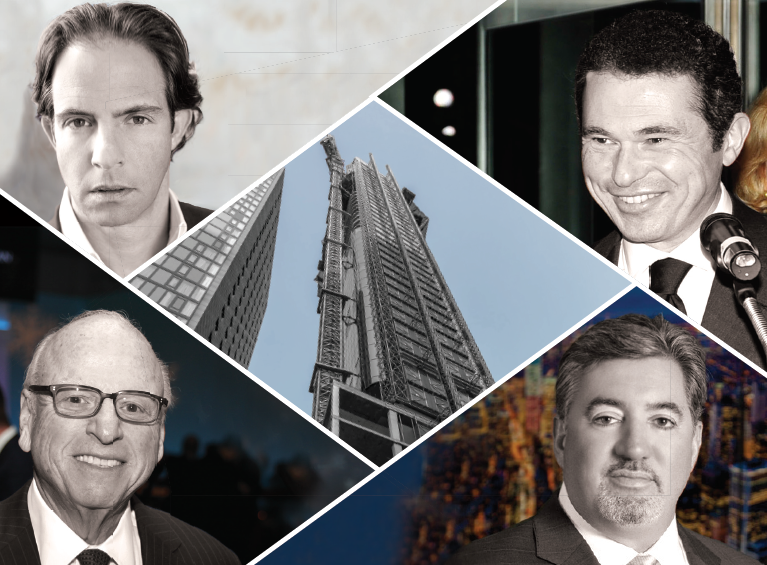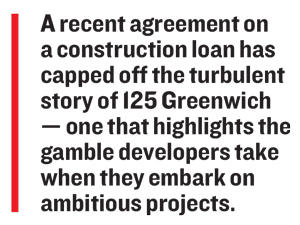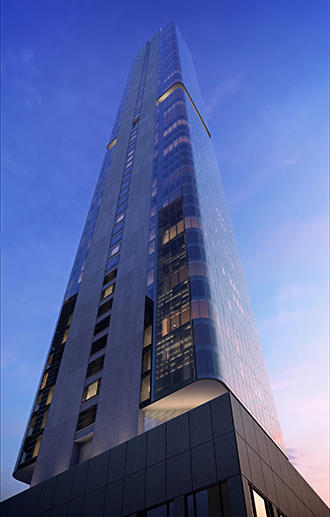In May 2014, a super-skinny, supertall tower was rising above the ground at 432 Park Avenue. The Rafael Viñoly-designed building — deemed an eyesore by some and a masterpiece by others — ultimately topped out at 1,396 feet, making it the tallest residential building in the Western Hemisphere.
At the time, Michael Shvo, the flamboyant real estate broker-turned-developer, was looking to make a splash on the New York real estate scene, and an opportunity emerged across the street from One World Trade: another Viñoly-designed supertall. It would be Downtown’s answer to 432 Park — if not in price, in appearance.
Shvo and a handful of New York real estate heavyweights bought the site at 22 Thames Street for $185 million and rebranded it 125 Greenwich, a residential condo building that would top out by August 2018.
But by the start of September this year, the tower was only three-quarters built, it had no construction loan, internal legal battles had flared, Shvo had pleaded guilty to tax evasion charges and the remaining parties were facing a $500 million shortfall. Construction crews would be walking off the job by the end of the month if the project didn’t find a lifeline.
“All these things take longer than people expect,” said Howard Lorber, the chairman of Douglas Elliman, who has an equity stake in the building.
A recent agreement on a construction loan has capped off the turbulent story of 125 Greenwich — one that highlights the gamble developers take when they embark on ambitious projects. Interviews with more than a dozen people connected to the building detail a scramble by the lenders and the project’s prominent players — including Lorber, developer Davide Bizzi and the recently deceased Howard Michaels — to sign off on a construction loan.
At one point, the situation was so concerning that the sponsors courted other prominent New York developers to help see the building to completion.
The large number of players involved — a dozen in total, including four Asian lenders, an EB-5 regional center and an Italian developer — also contributed to the delays.
“The time zones were brutal,” said Joseph Sarcinella, an attorney for Reed Smith who represented the United Overseas Bank, a Singapore-based firm that led the group of senior lenders in the deal.
In late September, after roughly three years, the developers signed the final term sheet and locked in a $473 million construction loan, bringing the total cost of the development to over $800 million. Given the project’s slow sales and a slump in average Financial District condo prices, the question remains: Will 125 Greenwich make a profit?
Starting from scratch
On Christmas Eve in 2012, demolition plans were filed for a 10-story property at 22 Thames Street. The owners, Witkoff Group and Fisher Brothers, had bought the former American Stock Exchange-owned building for $87.5 million and hired Viñoly to design a 960-foot tower, the tallest residential rental in Lower Manhattan.
But in 2014, the duo changed course and tapped New York-based HFF to market the site.
 At the time, Michael Shvo was establishing the portfolio of his eponymous development company and had signed deals to develop properties at 565 Broome and the old Getty gas station in Chelsea. The opportunity at 22 Thames offered something of a Downtown visual counterweight to 432 Park at a time when prices were soaring.
At the time, Michael Shvo was establishing the portfolio of his eponymous development company and had signed deals to develop properties at 565 Broome and the old Getty gas station in Chelsea. The opportunity at 22 Thames offered something of a Downtown visual counterweight to 432 Park at a time when prices were soaring.
“I thought this project was perfect to create a supertall Downtown, something that did not exist,” Shvo said.
At the end of May 2014, Shvo put down a $15 million deposit, and the sellers gave him 90 days to close the $185 million balance. His first call was to Michaels, the bullish debt broker, and his firm, the Carlton Group, to arrange a debt portion.
Shvo then set out to recruit industry veterans to co-develop the tower with him.
Bizzi — whose firm Bizzi & Partners worked with Shvo on 565 Broome and had a renowned construction arm —agreed to partner with him. Bizzi then asked Lorber and his investment firm, New Valley, to join. Lorber agreed on the condition that Elliman, his residential brokerage, would market the project. “I have a relationship with Bizzi,” Lorber said in an interview last month. “And we were already getting the exclusive marketing rights.”
Shvo, Lorber and Bizzi agreed to split a $28 million equity portion, paying $9.33 million apiece. The Carlton Group, meanwhile, had locked in an unlikely lender: United Overseas Bank.
The Asian bank wasn’t known for providing land loans, but with the prospect of leading a $500 million construction loan further down the road, it agreed to a $170 million debt package, which included a mezzanine portion by Indian-owned firm Taro Pharmaceutical Industries.
Extra funding was still needed to cover predevelopment costs, including a new Viñoly design and the pouring of the foundation. HFF brokered a deal with Chinese firm Cindat to join as a limited partner and invest $42 million in equity.
As the deadline neared, Michaels agreed to take $2 million of Lorber’s equity share.
On August 28, 2014, 125 Greenwich cleared its first challenge: It had lined up $240 million from seven firms in just 90 days.
The hard part
With the site now acquired, there remained a question mark over what the tower would look like and how it was going to be paid for.
Initial plans for the building varied wildly. It was first envisioned at almost 1,400 feet and then dropped to 800 before the developers settled at 912. The partners agreed that unlike the ultra-luxury apartments at 432 Park, 125 Greenwich would house condos starting at just over $1 million, which aligned with the Financial District’s prices. Instead of penthouses, luxury amenities would fill the top three floors. As the design took shape, the partners began negotiating with UOB to lead a $540 million construction loan package. In December 2015, the parties drafted a term sheet that said UOB would syndicate the loan and that Cindat would commit to $60 million in preferred equity, making it the majority equity holder.

Clockwise from top left: Michael Shvo, Davide Bizzi, Nick Mastroianni II and Howard Lorber
The foundations were poured in March 2015, but costs ran higher than expected, and Bizzi shifted the site from a union job to open shop, meaning labor costs would be cheaper, according to three people with knowledge of project. Without a construction loan officially locked in and predevelopment capital dwindling, the developers needed quick funding to get the tower out of the ground.
They brought in the U.S. Immigration Fund, an EB-5 visa regional center that tracks down foreign investors to provide cash in exchange for U.S. visas. The firm, led by Nick Mastroianni II, was commissioned to bring in $194 million.
The consortium of seven became almost a dozen. But with Mastroianni’s entry, cracks began to appear in the partnership.
Michaels, who was famously litigious, accused the parties of financially leapfrogging him. In March 2016, Michaels filed a lawsuit in New York State Supreme Court against Shvo and Bizzi, claiming that he and the Carlton Group were owed almost $4 million in unpaid commissions for bringing in Mastroianni’s firm and Lorber’s initial equity investment, according to court filings.
But Mastroianni disputed the claim. “I did not negotiate the terms of the EB-5 financing of 125 Greenwich in the executed term sheet with Howard Michaels or anyone else at Carlton Group,” Mastroianni said in a sworn affidavit.
As the dispute went on, progress on the construction loan stagnated, and on September 8, 2016, the project suffered another blow. Shvo, the face of the project, was indicted by the Manhattan District Attorney on tax evasion charges related to $1 million in purchases of fine art, furniture, jewelry and a Ferrari. He faced a maximum 15 years in prison.
“It really put a dampener on the construction loan,” Mastroianni said in an interview.
The prospect of a supertall luxury building being constructed by an alleged felon rankled lenders and posed a marketing hazard. According to three people involved in the project, Bank of China, which was looking to join as a senior lender, led the charge to remove Shvo from the project. A representative for the bank disputed that characterization.
Under pressure from Lorber and Bizzi, Shvo signed an agreement two months later to sell his stake in the project to Cindat once the construction loan was in place, according to multiple people.
“The partners had no legal right to force me out,” Shvo said. “I thought the responsible thing to do was sell my shares.”
Plan B
By 2017, the Financial District’s newest supertall building was being built on borrowed time: It still had no construction loan and was instead relying on a depleting line of EB-5 capital raised by Mastroianni.

In addition, after years of solid new development growth, signs were beginning to emerge that the market was about to take a turn for the worst.
New development condo sales dropped 13 percent year-over-year in 2017, and market experts predicted a major oversupply of condos.
With Shvo out of the picture, the job of seeing the project to completion fell on Bizzi & Partners. According to four people involved in the discussions, executives at New Valley and Bizzi spoke to the Witkoff Group and Michael Stern’s JDS Development about signing on to finish the job.
But the discussions fell apart.
“Nobody would come into this deal today,” said one person who was involved in the talks. “Their money is not going to get returned.”
In addition, UOB had another barrier keeping the construction loan out of reach.
The bank required a minimum number of units to be pre-sold before it would finalize the loan, according to multiple people. But the marketing team at Elliman had launched sales in September 2017, just as the market was turning south.
Nine months later, around mid-2018, the building was more than half finished without a construction loan. And now there was urgency — sales were crawling, and the partners were on pace to burn through their EB-5 capital by September. In June, another term sheet was drafted for a construction loan, which would be syndicated by UOB and three other Chinese banks. But now the market was far weaker, and the loan came in at $473 million — almost $70 million lower than the initial offering.
June turned into September, and almost a dozen firms were still dialing into daily phone calls from Europe, East Asia and the U.S. to try to close the deal.
Insiders say the final terms were held up by a refusal from Bizzi and Cindat to agree on guarantees to the lending consortium.
Multiple people said that by mid-September — as it remained unclear when negotiations would conclude — construction crews began to reduce their headcounts at the site. “I did hear certain contractors were staffing less,” Sarcinella said.
During the third week of September, the project ran out of money.
A day in September
On the morning of Friday, September 21, Howard Michaels died. The 62-year-old real estate stalwart had been quietly battling cancer, and, according to those close to him, worked almost until his death.
At 4:56 p.m. that day, an email was sent across the world to firms involved in 125 Greenwich, proclaiming that an agreement had finally been met for the $473 million funding package. It was 31 months after the first term sheet was drafted.
It is still too early to determine whether the $800 million project — where occupancy is now expected in September 2019 — will succeed.
In early October, the developers filed paperwork with the New York State Attorney General’s office listing the projected sellout at $868.4 million.
But multiple analysts say the building is priced 10 percent higher than the surrounding Financial District market.
According to an analysis by TRD, average prices at 125 Greenwich are $2,836 a square foot. At that price, the building stands to generate about $60 million in profit — before a 13,000-square-foot retail portion is sold. That figure is higher than the average $2,560 new development sales price for the Financial District, according to Stribling & Associates.
Since sales launched last year, less than 15 percent of the units have been sold, according to three sources with knowledge of the sales.
Garrett Derderian, Stribling’s director of data and research, said there are currently 14 new or planned condo developments in the area that are “adding a considerable amount of inventory to what is already a heavily discounted market.”
Shvo, who pleaded guilty to tax evasion in April and paid a $3.5 million fine, is the only person to have safely pulled his money out of the project he launched four years ago. Those with a remaining stake in the project brushed off the tower’s history.
“There were some challenges,” said Mastroianni. “But the project never really skipped a beat.”
Correction: A previous version of this story incorrectly referred to the U.S. Immigration Fund as the U.S. Investment Fund.
